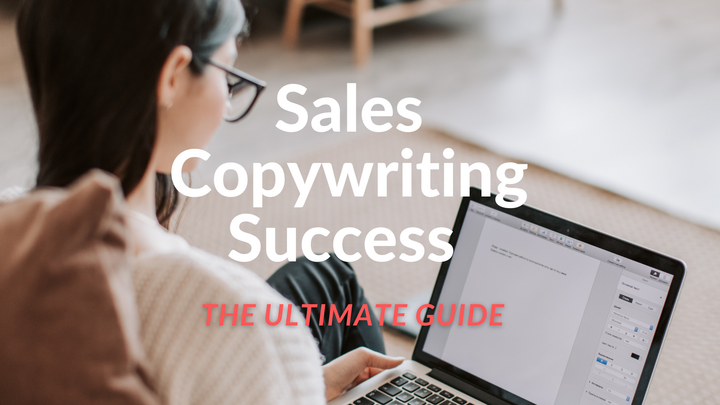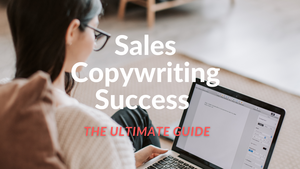Article Information
- Posted By : connexion.zone marketing
- Posted On : Apr 08, 2022
- Views : 77214
- Category : Marketing & Media
- Description : Copywriting is part art part science. This article demystifies copywriting for sales and salespeople.
Overview

Sales Copywriting success
The Ultimate Guide
Copywriting is a form of persuasive writing that uses techniques like storytelling and psychology in order to convince people and ultimately get them to take action. This makes it a type of marketing, but unlike most marketing, it isn’t simply advertising or just telling people about your product. Copywriting is a form of salesmanship—it’s the art of convincing someone directly to buy something from you.
This can include product description copy, sales offer copy, marketing emails, landing pages and more.Effective Sales Copywriting has been proven to be an effective way for businesses to make more money. While the writing itself is not usually seen as an art form, there are many things that go into creating good copy, including creativity and knowledge of marketing lingo.
In sales copywriting, you write a message that motivates a person to click on an ad, call a phone number, or fill out a form. And it's much more important than in other forms of business writing, because the sale is all that matters to you. Your goal is to have your prospect make a purchase…or at least take some action that moves him closer to making a purchase.Please note that “copywriting” refers to anything written in order to promote something else. This means you can be writing a sales letter or brochure but also anything from Facebook ads and billboards to company emails and descriptions on your website. Copywriting is one of the most essential elements of marketing, which means it’s going to be part of your job no matter what industry you work in or what position you hold within an organization. You need copywriters who can create product descriptions, sales offers, marketing emails and so much more.
Frameworks for Sales Copywriting
-
AIDA:
Attention, Interest, Desire, Action.
This is a widely used framework in sales copywriting, especially in advertising. The writer grabs the reader’s attention by using emotion-triggering words and phrases, then creates interest by painting a picture of the product’s benefits and how it will improve their life. The writer will then focus on building up desire for the product with emotional language, and provide an obvious call to action so that the reader can get it for themselves.
-
Before-After-Bridge:
Before shows what life was like before your product/service -- boring and mundane. After shows what life is like after using your product/service -- more exciting, fun and fulfilling! Finally, you need to bridge these two elements together so that it feels logical (and also desirable) to switch from before to after.
-
Feature to Benefits:
Instead of listing out products features (i.e., “It has 2GB RAM” or “It comes with a 3 year warranty”), you translate them into benefits (i.e., “You’ll be able to multitask easily!” or “You won’t have to worry about your laptop breaking down in 3 years time!”). This way of writing helps customers understand why they should buy your products instead of someone else's who offers similar features at a cheaper price point?
Understanding the concept of 'AIDA' in sales copy
The four elements of AIDA are as follows:
-
Attention: draw the attention of the readers to your product or service. This step is all about being noticed in a crowded marketplace.
-
Interest: get prospects interested in what you have to offer by stating benefits, not features, and appealing to their wants and needs – not just their reason alone.
-
Desire: create a desire among prospects for your product or service, using imagination and enthusiasm to capture their hearts as well as minds.
-
Action: persuade and influence prospects so that they take action, e.g., buy your product or service, or sign up for your newsletter/webinar/training course etc.

Using the concept of 'AIDA' in sales copy
Before you start writing your sales copy, ask yourself the following questions:- What are my goals?
- Why would someone care about my offer?
- Who am I talking to? How can I write in a way that appeals to them?
Creating a great headline is the first step toward perfecting your sales copy. Your headline should be informative and make the reader want to learn more about the product. For example, if you’re selling compost bins, then something like “Make Money with Compost Bins” could pique people’s interest.
The opening of your sales copy should help you further define why someone may be interested in what you’re offering. You can use a statistic or a story here to get their attention and reveal more about your product or service.
Finally, for an effective introduction, it's important that you clearly explain exactly what it is that you're offering to solve your audience's problems or meet their needs.
Understanding the concept of 'Before-After-Bridge' in sales copywriting
The Before-After-Bridge technique is a sales copywriting technique that works very well to attract the attention of your prospects and convince them to buy.Here’s how it works:
Before: First, you describe the problem that the prospect is facing. You tell the prospect that you are going to provide a solution for this problem. Don’t skimp on describing the details of this problem as it helps you grab their attention and make them want a solution.
After: Now you introduce your product/service as the solution that will solve all their problems and change their lives forever. Make sure you highlight how awesome your product/service is and all its benefits. You can also throw in some social proof here by mentioning how other people have benefited from using your product/service to get them closer to making the buying decision.
Bridge: Once you have described the problem and introduced your product as a solution, it’s time to build up anticipation among your prospects so they start craving more information about your solution (your product). This bridge is like a ‘cliffhanger’ in movies or TV shows which leaves viewers wanting more information so they come back to watch what happens next (or read what happens next).
How to write Before-After-Bridge sales copy

You can write Before-After-Bridge copy by following these 3 steps.-
Identify the before situation: It’s the current situation of your product or service. It shows what your product or service can do in its current form. Example: Our app allows you to make interactive infographics without having to learn design from scratch.
-
Identify the after situation: It’s the future situation of your product or service wherein it does exactly what your prospect needs it to do for them. Example: Our app will allow you to create stunning infographics that make people pay attention and take action in just a few minutes!
-
Bridge the before and after situations: This is where you explain how they get from one step to another, i.e., how they make the transition from their current state (before) to their desired state (after). Example: With our app, you get access to hundreds of pre-made templates that are proven to convert visitors into leads and buyers with just a few clicks of your mouse!
Understanding the concept of 'Feature to Benefit' sales copy

The term ‘Features to Benefits’ ratio is often used when it comes to writing a sales page or sales letter and the interpretation of this is fairly simple.With features, you describe the product or service in some kind of detail.
Benefits then follow on from this – they are what makes that product or service worthwhile for a consumer – why should they want it?
This means benefits are the emotional appeal, which is what sells products!
A good way to think about the difference between a feature and benefit is this; features are cold facts and benefits are how these facts make people feel. For example, ‘This cleaner has 4 times more bleach than rival brands’ would be a feature, whereas ‘This cleaner will get rid of even your most stubborn stains in seconds leaving your home sparkly clean’ would be the benefit.
How to write effective 'Feature to Benefit' sales copy?
You may have a great product, but you still need to communicate the value of that product to your potential customer. Some people believe that writing features of the product is enough, but this is not the case. The features of a product should be written in a way that communicates the benefits to the reader.A feature is a description of a product. For example, "Hippy Fire offers an unlimited internet plan for less than $80 per month."
A benefit describes how that feature would be useful or valuable to the reader. For example, "For under $80 you can get access to our unlimited internet plan and save on your broadband bill each month."
Understanding the concept of 'Feature Advantage Benefit' in sales copywriting
You may not have heard of Feature Advantage Benefit, but you’ve probably seen it in action. It’s a copywriting technique that can help your sales pitch by highlighting what makes your product or service worth buying. It’s so effective and common that many people now consider it an essential copywriting skill, especially when selling products online.
How does Feature Advantage Benefit work? When you’re writing content for an ad, you need to know what sets your product apart from the competition and why consumers will want to buy it. So before you start writing the body of your sales page or the script for a video ad, ask yourself these questions: What is the feature of my product? What advantages does it offer to people who use it? And at its core, what benefit does this product provide?
For example, suppose I had a new room deodoriser that was made with all-natural ingredients like lavender and citrus oils (feature). Unlike other deodorisers on the market that mask odors instead of addressing their cause by covering them up with strong scents (advantage), this one uses botanical extracts to absorb odors rather than just covering them up (benefit). The following day I get an email saying “Now there’s no excuse not to use our new all-natural room deodoriser because we give you all three reasons why: 1) It uses botanical extracts 2) They are environmentally friendly 3) They are effective at removing odors.How to write effective 'Feature Advantage Benefit' in sales copy
With any product or service, success tends to hinge on selling the benefits. It’s not enough that your product is good, or even great; it needs to be the best one out there. An effective way to do this is through the use of “Feature Advantage Benefit (FAB)” copywriting.What are FABs?
A “feature” is a particular thing about your product or service that sets it apart from the competition. A feature might be something like “hand-sewn seams made of eco-friendly material” or “free overnight delivery with every order.” You can add as many features as you want, but they only serve as an introduction to what will ultimately sell your product: its benefits. The feature is like saying you have a car; the benefit is saying it gets you from point A to point B in 30 minutes flat.In order for a customer to get from point A (knowing their problem) to point B (your solution), they need help identifying how your feature relates back to them and their needs—this is where advantages come into play. Your advantages should communicate why your features matter by highlighting how your customer could use them, such as how hand-sewn seams might be more durable than machine sewn seams, and thus will last longer for them and prevent them from having to buy another item right away, saving time and money in the long run. Once you know your advantage, you can figure out what benefit you offer…which brings us back full circle!
How to create marketing angles for your product?

Often, it’s finding the right marketing angle that gets you sales.
You can create a new product with similar features as your competitor but the one who creates a unique marketing angle will win more customers and get more sales.
So how do you create a marketing angle? Here are some ways to find an effective and unique marketing angle:
-
Your product should solve a problem: As mentioned earlier, people buy solutions to their problems. So, if you can identify some of the most pressing problems faced by your target market, you can create products based on those problems. Apart from solving a problem or fulfilling a need, successful products should be easy to sell through effective communication.
-
Your product should aim to make your target audience happy: People love buying things that make them happy which is why many products like perfumes and chocolates do so well in the market. In order to make your customers happy and feel fulfilled all you have to do is identify what gives them happiness and create a product that fulfills that need for them in some way or another (for example by making them look good).
-
Your product should be an improvement on existing solutions available: As humans we like having better options than what we already have, this is why many big companies always try improving their existing products so they can stay ahead of competition. If there are any existing solutions available for any problem faced by your target audience then think about how you can improve upon those solutions in order to give people something better than what they already have access too (which will motivate them into buying from you).
Understanding the concept of 'Pain Agitate Solution' in sales copywriting
How do you get your prospect to buy? By identifying his pain and agitating it until he's ready to hand over his money.
Our first step is setting a tone of calm and confidence. We don't want to sound like we're trying to sell him something, like the stereotypical harried car salesman. The voice has to be one of trust, friendliness and warmth. We need to be able to persuade our prospects that there's a solution for them—but it can't just be "Buy this." A great solution must explain how the product or service in question works and why it will solve their problem. It should also give them confidence that they'll get results as opposed to guarantees or guarantees that they won't get results, which can make them feel trapped or forced into buying something they don't necessarily want.
The next thing we need is an offer—the more specific the better. This offer needs to show that the problem is real and that our product or service really delivers on solving it, with proof provided (i.e., testimonials). We also need to make sure we have enough convincing evidence of the benefits before presenting any guarantee if one is necessary (as well as what kind of guarantee we'll provide).
The last step in our sales copywriting process is telling your prospect how much you're going to charge for your solution (this gets re-iterated when you close the sale).
How to write effective 'Pain Agitate Solution' in sales copy
-
Ask Questions About the Pains
The pain is the reason that people are looking for your product in the first place. When you ask questions about their struggles, it gets them thinking about how they really feel. This usually generates a fair amount of emotion, which is crucial for making sales. Here are some examples:
-
Have you ever ... ?
-
Do you know what I hate?
-
Can you relate to this?
-
Give a Solution to Their Pains
Once their pains are identified, give them a solution right away! People don't want to hear much more of their problems once they're aware of them. They want solutions. It's up to your product or service (or even just your offer) to be that solution!
Understanding the concept of 'Problem Promise Proof Proposal' in sales copywriting
In the world of sales, there is a concept called Problem Promise Proof Proposal or P4. This is a method used to convince customers that your product is the best one for them. It consists of four steps:-
Identify the problem or need
-
Promising to solve it in an exciting way
-
Providing proof that you can deliver on this promise
-
Offering a solution that they cannot refuse

Using the concept of 'Problem Promise Proof Proposal' in sales copywriting
You’ve heard of the classic problem-solution formula, right? The way it works is easy: you describe a problem, then offer a solution. But in sales copywriting, we need to go beyond this.Instead of just describing a problem and offering a solution, you want to demonstrate that your solution actually works too. This is where Proof comes in. We use this stage to show that our promise is real and can deliver the results we’ve promised.
Now that you’ve described the Problem and offered your reader some Promise to solve it, now we need to prove it before proposing any solutions or suggestions for purchase!
Understanding the concept of 'Problem Promise Proof Proposal' in sales copywriting
In the field of sales copywriting, the concept of "Problem Promise Proof Proposal" (PPPP) is becoming more and more popular. It's a great way to create effective sales message that appeals to your prospects by showing that you understand their problem, you have a solution for them and the proof to back it up - and then asking them if they would like to have this solution.But what is "Problem Promise Proof Proposal"? Well, it's basically just an acronym that helps you remember four key elements of your sales message:
-
Problem - Show your prospects that you understand their problem
-
Promise - Tell them how you can solve it for them
-
Proof - Give them evidence that supports this promise
-
Proposal - Ask for the sale or whatever it is you want from your prospect
How to write effective 'Problem Promise Proof Proposal' sales copy
As you start to write your sales copy, follow these four steps:-
Write a clear problem statement
Make sure that your customers feel like you have thoroughly understood their needs and problems.
-
Promise a solution to the problem
Articulate the benefits of your product or service in terms of how it solves your customers' problems. You can also promise things like 'faster', 'easier', 'more efficient' and so on. For example, if they want to save money, make sure that you tell them how much they can save with your product/service.
-
Prove that you can deliver on this promise (effectively!) by talking about past customers who have used the product/service successfully
In this section, you need to quantify the results that other people have gotten using your products or services. This gives potential customers proof for why it's worth investing in what you're selling. Quantification is key here – words such as 'drastically increased' or 'greatly improved' are too vague – be as specific as possible! Testimonials from satisfied existing customers are also very powerful at this point in your sales copy. And if there's any sense of scarcity involved here (such as limited quantities), make sure that your readers know!
Understanding the concept of QUEST copywriting in sales copy writing
Once you’re clear on your goals, it’s time to understand what the client wants. This is why copywriters ask so many questions — and not just about what products or services the client sells.
A good copywriter will also get to know the target audience and learn as much as possible about their unique needs, problems, objectives and buying behavior.
Once you understand the client’s business and target audience, it’s time to educate them. When people are researching something they need, they often don’t know all the details until they hear them explained by an expert.
This is a great place to showcase your knowledge of copywriting, marketing and sales theory. It makes clients feel like they found a “real pro” who knows what they’re doing!
Using QUEST copywriting
QUEST copywriting works for a reason. The “sequence of thought” that it follows is the same sequence of thoughts that your customers have when they're considering making a purchase from you. And, since we know this, it’s important to remember that there are many other ways to use QUEST copywriting—not just in sales letters. You can use it to write effective articles, blog posts and even emails.Understanding the concept of QUEST copywriting in sales copy writing
QUEST is a sales copywriting technique that can be used to keep your copy focused on the key points.
These are:-
Question - What is your goal?
-
Understand - What does the client want?
-
Educate - What does the client need?
-
Sell - What can you offer?
-
Testimonials - What do your customers say?
Successful Sales Copywriting is specific type of writing which focuses on creating products, services, events and more.
Copywriters are responsible for creating the words on almost all advertisements including television commercials, radio ads, newsletters, website pages, and more. They also write text for social media channels such as Facebook posts and tweets. These are all types of copywriting known as “ad copy” because they advertise something specific (a product or service) with the intention of getting someone to buy that product or service.
It's very important to create a bond of trust and loyalty with your customers. Once they see you as a person they can associate with, they will be able to trust you and easily make buying decisions. This is why sticking with the fundamentals is pretty much imperative: it's the baseline for building a relationship of trust between yourself and your audience.-
